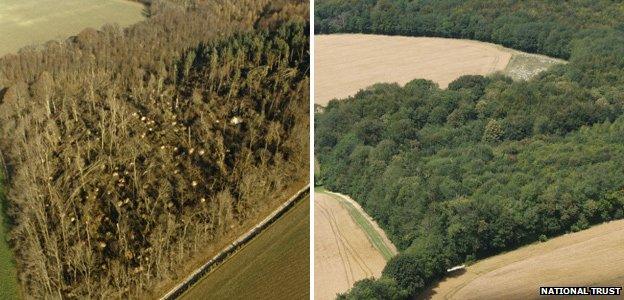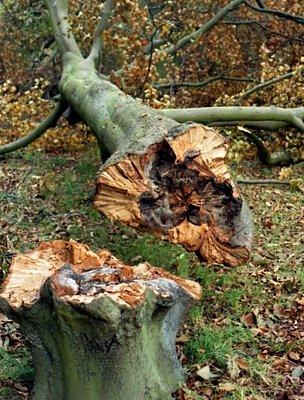Great Storm: The healing power of nature
- Published

The 1987 storm opened up woodland canopies (left); by 2007, a new generation of trees had filled the gaps
After wreaking havoc throughout the night of Thursday 15 October 1987, it was at first light the following morning that the damage caused by hurricane-force winds across southern and south-eastern parts of the UK could be truly assessed.
And when the extent of the devastation was finally tallied, 18 people had lost their lives and the storm was listed as the most expensive weather-related event in the history of the British insurance industry.
Also, landscapes familiar for generations had changed forever.
An estimated 15 million trees were uprooted, countless more were damaged in the few hours that the Great Storm, with winds recorded at speeds in excess of 160 km/h (100mph; 86 knots) wreaked havoc across woodlands and plantations.
At Toys Hill, the highest point in Kent, about 98% of the woodland - including many veteran beech trees that had adorned the hillside for centuries - was lost.
Copperas Wood nature reserve in Essex lost almost three-quarters of its ancient woodland, which primarily consisted of coppiced sweet chestnut and hornbeam.
Although the immediate aftermath left people in a sense of shock of how the landscape had changed beyond recognition overnight, Keith Kirby - who at the time worked for English Nature (which later became Natural England) - said it could later be seen as a blessing in disguise for woodland ecology.
"The immediate reaction was that everyone thought that it was a great disaster but I think, with hindsight - on the whole - it was beneficial in many respects," he told BBC News.
"Until then, we had not fully appreciated just how uniform our woods were becoming."
Then and now: BBC weather presenter Peter Gibbs finds out how forecasting has changed
Dr Kirby, who co-edited a 1993 report on the storm's ecological impact on woodlands, explained that, at the time, many of the woods' canopies were closing over as the trees entered the young, mature stage of their lifecycle.
The previous time wood was in such high demand and vast numbers of trees were felled was during the Second World War, he explained.
"The last remnants of active coppicing were also dying out, so the woods were getting into a fairly dark and shady state."
The lack of light meant that much of the low-level flora and fauna that favoured woodland conditions were struggling.
"With the storm coming along when it did, it helped break up those canopies in some places and create some gaps that otherwise would not have occurred," Dr Kirby, now a visiting researcher at Oxford University's Department of Plant Science, observed.
He recalled how one long-term monitoring project, which ran from 1971 to 2001, looked at 100 woodland plots across the UK, shedding some light on one of the possible silver linings to an otherwise devastating weather event.

The storm felled an estimated 15 million trees across southern and south-east England
"One of things that we found was that, on the whole, the flora had become thinned out and there was a lower species richness - except in about 10 of the woods.
"When we looked at where [the 10 plots] were, they were all in south-east England and they were all within the storm track."
The abrupt opening of the woodlands' thick canopies offered a lifeline to plants and butterflies that had once thrived in these habitats.
Dr Kirby observed: "It is more the commoner woodland species - such as primrose and bluebells - that can survive under shade, but if the shade continues for long periods then their density does thin out.
"It was the regular opening of the canopies through the coppice regimes in the past that meant a lot of our woodlands had these great displays of spring flowers.
"Woodland butterflies, fritillaries in particular, are associated with gaps or temporary hotspots within the woods."
He added that there was no evidence to confirm that they did benefit from the storm, but "what we do know is that their trend has been in general decline through most of Britain and this has been associated with increased shade".
"The storm might have given them a temporary respite but, unfortunately, it was only temporary and the decline is now continuing."
Changing composition
The other co-editor of the 1993 report, Peter Buckley, said another ecological benefit of the storm was that it changed the composition of woodlands from, in many cases, almost monocultures.
"For example, a lot of the beech on the Downs were felled (in the storm) and were succeeded by birch and other pioneer species," he explained.
So there has been a break-up of some of the monoculture and clonal vegetation patches underneath the trees."
Dr Buckley said that the impact of the storm also offered an insight into how woodlands were vulnerable to extreme weather.
"It did show that plantations did not stand up particularly well to these types of storms because you have lots of trees crammed together, with small root systems and they grow tall," he told BBC News.
"Whereas in the old traditional approach of coppicing, you could argue that the trees are kept short so they do not offer so much wind resistance.

Floral species, such as bluebells, favour lighter woodland conditions
"In fact, the big standard trees in the old coppicing-with-standards system, external grew up more or less exposed, so developed wind firmness over time.
"What the storm showed was that trees which had probably reached their full height but were still young and not securely anchored blew over very easily.
"Those that had been in situ for a very long time had had time to spread their roots, or trees on the edge of plantations that did not have so much competition on the outside of the stand, these stood up and did pretty well."
Dr Buckley estimated that about half of the trees lost during the 1987 Great Storm were young plantation trees.
The National Trust, one of the UK's largest landowners, lost hundreds of thousands of trees on its properties in the storm.
While fallen trees caused an acute problem for the Trust in formal landscapes, the loss of so many trees did allow its experts to review how to manage its woodlands.
"One of the legacies we have learned from the Great Storm is that woodlands look after themselves pretty well," explained head of forestry Ray Hawes.
"Just after the storm, one of my colleagues went over a lot of our parks and gardens and took a lot of aerial shots in order to get an idea of tree and woodland damage.
"For the 20th anniversary of the storm, we redid it. Some of the areas that had not been replanted were basically back to woodlands - they regenerated naturally.
"Whereas if you try planting trees into these systems at an early stage, then you end up with a huge maintenance job to look after the trees you planted, because they are being swamped by the natural regeneration trees, which tend to be more vigorous.
"This is because they come out of the ground straight from seed; they have not had the shock of being taken from a nursery and planted in the ground.
"So now, we would leave a lot of woodlands to see what happens naturally," Mr Hawes told BBC News.
- Published15 October 2012